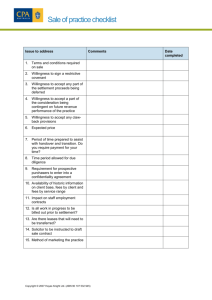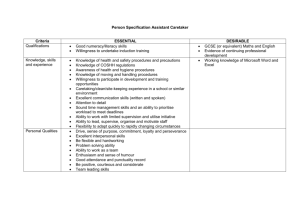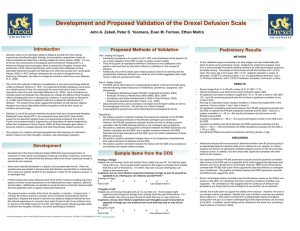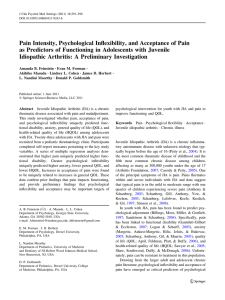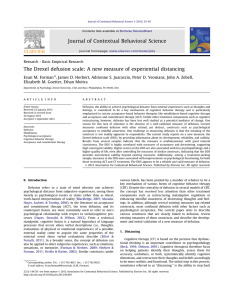Acceptance and Commitment Therapy: Introduction & Skills Building
advertisement
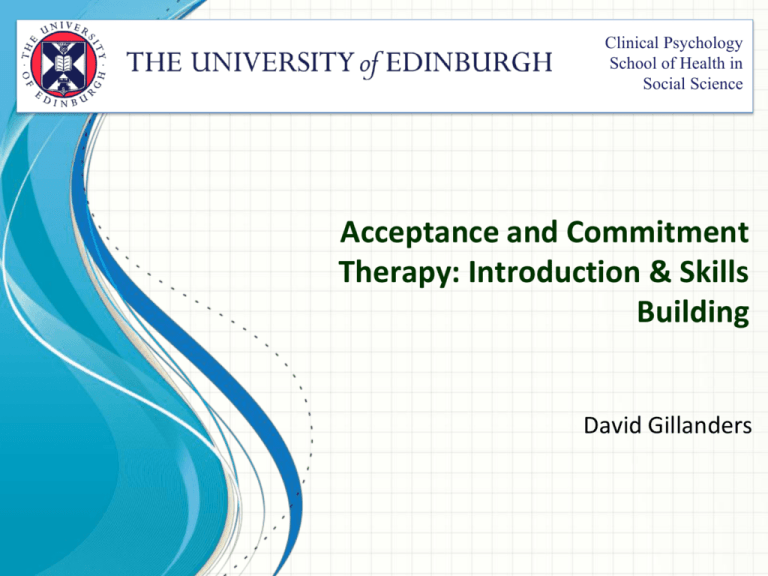
Clinical Psychology School of Health in Social Science Acceptance and Commitment Therapy: Introduction & Skills Building David Gillanders 3 elements of ACT training Knowledge & Concepts Skills & Techniques Personal Qualities Setting the scene Setting the scene your self care zon e Beggining • So lets just linger here a moment… The ACT Model “ACT is a therapy approach that uses Acceptance & Mindfulness processes and Commitment and Behaviour Change processes to produce greater psychological flexibility” Hayes et. al., 2004 “Psychological flexibility is the ability to contact the present moment more fully as a conscious human being and to either change behaviour or persist, when doing so serves valued ends”. Wilson & Murrell, 2005 Expansive & growth oriented Non-eliminative Behaviourally defined Not a ‘mind model’ Specifies functional processes What is it that is influencing our behaviour in any given moment? Some basics • Form and function • What do we mean by context? The ACT Model of Inflexibility Dominance of Past & Future Lack of clarity or contact with Values Experiential avoidance Psychological inflexibility Inaction, impulsivity or avoidant persistence Cognitive Fusion Attachment to the self ‘story’ The Psychological Processes ACT Seeks to Strengthen Being in the present moment Clarity & Contact with Values Acceptance / Willingness Psychological Flexibility Committed Actions Defusion Flexible Self Key Concepts in ACT Acceptance & Mindfulness Processes Being in the present moment Acceptance / Willingness Clarity & Contact with Values Components of ACT Committed Actions Defusion Flexible Self Key Concepts in ACT Being in the present moment Acceptance / Willingness Commitment and Behaviour Change Processes Clarity & Contact with Values Components of ACT Committed Actions Defusion Flexible Self The Psychological Processes ACT Seeks to Strengthen Being in the present moment Clarity & Contact with Values Acceptance / Willingness Psychological Flexibility Committed Actions Defusion Flexible Self Steps in Therapy Assessment Case Conceptualisation Workability Analysis – ‘Creative Hopelessness’ Suggesting an alternative – willingness Why do that? – Values clarification & goal setting Commitment to valued action Ongoing working at flexible pursuit of valued living with less struggling via willingness, defusion, mindfulness. Assessment • What is the client looking for help with? • Describing the struggle • Thoughts, beliefs, emotions, behaviours, social, historical • Emphasising the experience of what happens and of how they are responding Functional analysis • What is the struggle? • What do they do in response? • What is the consequence of that? • How would they wish it to be different? Case Conceptualisation • What are workable strategies? • What are unworkable ones? • Which of the 6 processes do we need to strengthen? • You can use the hexaflex model to map out what drives the current strategies Case Example • John - early 30's, graphic designer • Chronic, severe irritable bowel syndrome, low mood, abdominal pain and discomfort • Low motivation, sense of defeat • Fears having a bowel accident in public, is very embarrassed and shamed • Feels disbelieved, has tried many things to control IBS • Has stopped socialising, changed his work to be more alone, stopped going out, stopped dating Case Example - Functional analysis • Struggle: symptoms, beliefs / thoughts, feelings • Response: what he does in response to the struggle • Consequences? • How workable are these strategies? The link between functional analysis and ACT • What combination of the 6 processes underpin or drive these unworkable strategies? Strategy Processes Looking for a cure Avoidance Fusion with beliefs: 'there must be a cure' Not socialising avoiding judgements and shame, avoiding accidents fusion with judgements about likelihood The ACT Model of Inflexibility Dominance of Past & Future Lack of clarity or contact with Values Experiential avoidance Psychological inflexibility Inaction, impulsivity or avoidant persistence Cognitive Fusion Attachment to the self ‘story’ The Psychological Processes ACT Seeks to Strengthen Being in the present moment Acceptance / Willingness Values Psychological Flexibility Committed Action Defusion Flexible Self Workability Analysis • Referred to as Creative Hopelessness • Use metaphors: The Sailing Boat The Rigged Game Maslow’s Hammer Who’s using who? ‘If you always do what you’ve always done..” • With heart for their struggle: validating Be explicit • Name these behaviours as strategies • Its the strategies that don't work • You are not broken, you have done everything that is supposed to work • What does that tell you? • Our work is about finding different strategies Workability Analysis • It might feel different • That might be scary – would you be willing? • Anticipating obstacles and old habits • Concretise / physicalise the strategies Informed Consent • This could be hard work, yet hard for a good reason. (Swamp & mountain Metaphor) • Client gets to choose willingness • A word about talking versus doing: (Metaphor of learning an instrument) (Description of a chair) Where to start? • Client and you are connected • They recognise something needs to change • They are willing to try something new • Left side or right side? Starting on the left side • If the person is clear about values and goals • Get a sense of the obstacles that come up • Use left side moves to hold them more flexibly Starting on the left side • Ask them to notice how they are when this stuff comes up • See if they would be willing to linger a moment with it, observe it • Do mindfulness of the breath and bring in something that is avoided Starting on the right side • If the person is less clear about values and goals • Help them to connect with what this unusual work will be about • Natural extension of creative hopelessness – sailing boat metaphor Doing the work • In each session you will be reviewing homework / progress / experience of last time • Then doing left or right side moves according to what is needed • In the service of the person’s values Therapeutic Stance » Modes of mind during therapy (Kelly Wilson): 2+4= 5–3= 111 ÷ 3.7 = 2 + 12 = Therapeutic Stance • How are you seeing your client: • Maths problem or sunset? • How are our clients perceiving themselves? Monitoring & Tracking » Mindful, present moment, defused, flexible, engaged attention » Helicoptering metaphor Helicoptering Metaphor Theory & Formulation Own current state Client’s perspective Client’s needs Client’s flexibility Case Work Exercise » Stance of appreciation » Helicoptering » Functional analysis on the fly » Shaping responding Case Work Exercise » In same threes as before: » Client - experience your client » Therapist - try it out, be imperfect, ask for help » Coach – monitor, feedback, advise, coach » 25 minutes: focus on moving from assessment to workability
